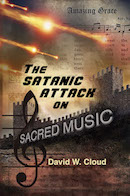866-295-4143, fbns@wayoflife.org
The “normal-literal” method of Bible interpretation refers to the manner in which human language is ordinarily interpreted.
This been called the “golden rule” of Bible interpretation: “When the plain sense of scripture makes common sense, seek no other sense, but take every word at its primary literal meaning unless the facts of the immediate context clearly indicate otherwise” (David Cooper).
“God says what He means and means what He says. We are to read the Bible just as read any other piece of writing, not trying to force some allegorical, mystical, or figurative meaning into its plain statements” (Bible Explorers Guide, John Phillips).
We use figures of speech, such as metaphors, in normal speech, but we understand that these are figures of speech by the context and we know how to interpret them. If I say, “I’m going for a run,” we know that this means that I am literally going to go running. But if I say, “I’m going to run down to the store,” we know this is a figure of speech, and it simply means that I am going to the store, whether by walking, driving, etc.
The same is true for Bible prophecy. It contains figures of speech, but the Bible makes it clear that these are figures of speech and teaches us how to interpret them either by the context itself or by comparing Scripture with Scripture.
Contrast the allegorical method of interpretation
The allegorical method interprets the prophetic portions of Scripture in a symbolic manner rather than a literal one. By this method, the Old Testament prophecies of Israel’s glorious earthly kingdom are interpreted as descriptions of the church age. So “Zion” is the church and “the thousand years” of Revelation 20 are the church age and the desert blossoming as the rose (Isa. 35:1) is fruitfulness in the church age.
Consider three examples:
The Geneva Bible note at Revelation 9:11 identifies “the Angel of the bottomless pit” as “Antichrist the Pope, king of hypocrites and Satan’s ambassador.” There is no reason, though, to see this angel as anything other than a literal fallen angel in a literal bottomless pit.
Adam Clarke on Revelation 20:2: “In what this binding of Satan consists, who can tell? ... it is not likely that the number, a thousand years, is to be taken literally here.”
Jamieson, Fausset, Brown on Revelation 20:2: “Thousand symbolizes that the world is perfectly leavened and pervaded by the divine; since thousand is ten, the number of the world, raised to the third power, three being the number of God.”
The history of allegoricalism
The early Christians interpreted prophecy literally (Ac. 3:19-21; Ro. 11:25-27). This is admitted by church historians.
Lutheran historian Adolph Harnack wrote, “Faith in the nearness of Christ’s Second Advent and the establishing of His reign of glory on the earth was undoubtedly a strong point in the primitive Christian church” (“Millennium,” Encyclopedia Brittanica).
The allegorical interpretation was invented by false teachers after the time of the apostles.
A school was established at Alexandria, Egypt, which became the headquarters for the allegorical method of interpretation. Egypt was a place where false teaching proliferated in the early centuries after Christ.
Origen (AD 185-254) and Augustine (354-430) were the chief fathers of allegoricalism. Louis Berkhof says, “Through the combined influence of Origin and Augustine, and of the Christianizing of the empire in the time of Constantine the Great, the Chiliastic [millennial] view of the Kingdom was gradually eclipsed by the representation of the Kingdom as a present reality” (The Kingdom of God, p. 113). Origen said, “The Scriptures have little use to those who understand them literally.” He described the literal meaning of Scripture as “bread” and encouraged the student to go beyond this to the “wine” of allegoricalism, whereby one can become intoxicated and transported to heavenly realms. Augustine taught that the millennium is fulfilled in the Christian Church. These men were laden down with heresies. Following are some of Origen’s: He taught baptismal regeneration, purgatory, the pre-existence of the human soul, universalism, the Holy Spirit was the first creature made by God, and Jesus is not fully God.
The Roman Catholic Church interpreted Bible prophecy allegorically throughout its history.
The Protestant denominations (e.g., Anglican, Presbyterian, Lutheran, Methodist) have also interpreted prophecy allegorically, with few exceptions. This is one of the errors they brought out of Rome.
Why we interpret the prophecies literally
First, God gave the Scriptures to REVEAL truth to man, not to hide it. See Deuteronomy 29:29. Prophecy is given to reveal secrets, not hide them. Prophecy is light, not darkness (2 Pe.1:19). The Bible’s final book of prophecy, Revelation, is so named because it is given to reveal truth, not hide it. Prophecy is to be understood in the normal way that human language is understood because it is God’s revelation to mankind in human language. God made human language, and He has communicated His revelation to man in normal human language that is interpreted in a normal way that language is interpreted.
Second, the apostles interpreted prophecy literally.
Consider two key passages:
Acts 3:18-21 - Peter preached that as there was a literal fulfillment of Christ’s first coming to suffer for man’s sin, so there will be a literal fulfillment of the prophecies pertaining to Israel’s conversion and kingdom. The heaven will receive Christ until He returns. Then there will be a “restitution of all things, which God hath spoken by the mouth of all his holy prophets.” Words could not be plainer. The prophecies of Israel’s regathering and conversion and blessing and the prophecies of Christ sitting on David’s throne will be literally fulfilled.
Romans 11:25-27 - Paul also taught that God’s covenants with Israel will be literally fulfilled. Israel is currently blind, except for those few, like Peter and Paul, who are saved. Israel will be blind only until the fulness of the Gentiles is come in, referring to the church age. Then Israel will be saved and her covenants fulfilled. Again, words could not be plainer.
That the apostles and the apostolic churches interpreted prophecy literally is admitted by most church historians, as we have seen.
The church at Antioch continued to interpret prophecy literally after the allegorical method was invented by heretics such as Origen (185-254). Antioch, of course, was an important church founded by Barnabas and Paul, and it is from this church that the first foreign missionaries were sent out (Acts 11:19-26; 13:1-4; 15:39-41). It was at Antioch that the disciples were first called Christians. Some of the preachers associated with Antioch were Lucian (died 312), Diodorus of Tarsus (d. 390), Chrysostom (d. 407), Theodore (d. 428), and Theodoret (d. 458). These men did not accept the Alexandrian allegorical method of interpretation. They interpreted Bible prophecy literally. Farrar says, “Diodorus of Tarsus’ books were devoted to an exposition of Scripture in its literal sense, and he wrote a treatise, now unhappily lost, ‘on the difference between allegory and spiritual insight’” (F. W. Farrar, History of Interpretation, pp. 213-15).
Third, Bible prophecies have always been fulfilled literally.
Prophecies about Israel were fulfilled literally.
Israel’s entire history was given in the great prophecy of Deuteronomy 28 (see particularly verses 63-67). This prophecy describes Israel’s defeat at the hands of foreign powers and her dispersion to the ends of the earth, and they have been fulfilled literally and precisely over the past 2,000 years, beginning with the Babylonian Captivity and then Rome’s destruction of Jerusalem in AD 70 and again in AD 135.
Prophecies of Christ’s first coming were fulfilled literally.
Consider the prophecy of Christ’s first coming in Psalm 22. In this Psalm alone, there are many specific prophecies about Christ’s death, and they were literally fulfilled:
Psa. 22:1 – Jesus’ words on the cross (Mt. 27:46)
Psa. 22:6-8, 12-13 – The people reviled Jesus (Mt. 27:39-44)
Psa. 22:11 – There were none to help Him (Mk. 14:50; Heb. 1:3)
Psa. 22:14-16 – They crucified Him (Mt. 27:35)
Psa. 22:14-15 - Christ’s thirst from blood loss (Joh. 19:28)
Psa. 22:17a – They did not break his bones (Joh. 19:33)
Psa. 22:17b – They stared at Him (Mt. 27:36)
Psa. 22:18 – They gambled for his garments (Mt. 27:35; Joh. 19:24)
Since Bible prophecy has always been fulfilled literally, there is no reason to believe that future prophecies will be fulfilled any differently.
Fourth, the Lord Jesus said the major prophetic events are yet future.
In His prophecy in Matthew 24, He described the Great Tribulation and the rule of the Antichrist and said that these events will occur in the future just prior to His literal return (Mt. 24:15-29). It is obvious, then, that the Great Tribulation is not something that has already been fulfilled in history or is being fulfilled, and it is obvious that the Antichrist is a literal man who will desecrate a literal third temple.
Fifth, Christ rebuked His disciples for not believing the prophecies in their literal interpretation (Lu. 24:25-27).
Sixth, the stage is set today for the literal fulfillment of the prophecies.
Everything is ready. The machinery for a one-world government and a one-world religion as described in Revelation 13 and 17 is being set up before our eyes. The technology is in place to control the world’s commerce as described in Revelation 13:16-17 and for the people of the world to observe the events described in Revelation 11:8-10. Most importantly, the nation Israel is back in her land in fulfillment of Ezekiel 37:1-14 (Ezekiel said she would return first in a spiritually-dead condition, verse 8) and in preparation for the literal fulfillment of the rest of her prophecies. She is making preparations to build the third temple, which will be desecrated by the Antichrist. She is looking for a peace-making, temple-building Messiah, which is exactly what the Antichrist will be at the beginning of his reign when he makes a seven-year covenant with Israel as per Daniel 9:27.
Seventh, practical necessity demands the literal interpretation of prophecy.
To interpret Bible prophecy allegorically destroys the absolute sense of God’s Word. It ceases to be a “sure word” (2 Pe. 1:19). If prophecy does not mean exactly what it says, there is no way to know what it does mean. Consider Revelation 20:1-3. If this passage does not mean that a literal angel binds a literal devil in a literal bottomless pit for a literal thousand years, we have no way of knowing for sure what it does mean. If it does not mean what it literally says, it could mean anything that any interpreter says it means.
Bible teacher Vernon McGee was trained in the allegorical method of interpretation, but he realized as a young man that it resulted in foolishness: “I went to a seminary that was amillennial, where they attempted to fit the rest of Revelation into the historical, or the amillennial, viewpoint. It became ridiculous and even comical at times. For example, when we reached the place where Scripture says that Satan was put into the bottomless pit, we were taught that that has already taken place. I asked the professor, ‘How do you explain the satanic activity that is taking place today?’ He replied, ‘Satan is chained, but he has a long chain on him. It is like when you take a cow out into a vacant lot and tether her out on a long rope and let her graze.’ That was his explanation! And my comment was, ‘Doctor, I think Satan’s got a pretty long chain on him then, because he is able to graze all over the world today!’ It really makes some Scriptures seem rather ridiculous when you follow the allegorical viewpoint” (Thru the Bible with J. Vernon McGee).
Eighth, prophecy as an apologetic demands a literal interpretation.
In Isaiah, Jehovah God Himself uses Bible prophecy as evidence that He is its Author. See Isaiah 41:22-23; 44:6-7; 45:21-22; 46:9-10. The reason that Bible prophecy can be used as an evidence of the divine inspiration of Scripture is that it is precise and clear. Charles Feinburg, who had a Ph.D. in Archaeology and Semitic Languages from Johns Hopkins University, observed, “Although the intellectual atmosphere of our times is against it, this literal fulfillment of Biblical prophecy remains to an open mind a strong apologetic for the supernatural character of the Scriptures” (Premillennialism or Amillennialism?, p. 212). Bible prophecy contains details such as names, dates, and places.
For example, Psalm 22 contains the details of Christ’s death, as we have seen. David wrote this 1,000 years before Christ. It is impossible for man to know such things about the future. For such details about a man’s life to be written in a book hundreds of years before his birth is irrefutable evidence that that book is of God. But if the details of the prophecies are not interpreted literally, the prophecies cannot be used as an apologetic because it will not be clear exactly what is being prophesied. If piercing of the hands and feet, for example, means something other than a literal piercing then the power of the prophecy as an apologetic is destroyed.
- Receive these reports by email
- www.wayoflife.org
______________________
Sharing Policy: Much of our material is available for free, such as the hundreds of articles at the Way of Life web site. Other items we sell to help fund our expensive literature and foreign church planting ministries. Way of Life's content falls into two categories: sharable and non-sharable. Things that we encourage you to share include the audio sermons, O Timothy magazine, FBIS articles, and the free eVideos and free eBooks. You are welcome to make copies of these at your own expense and share them with friends and family. You may also post parts of reports and/or entire reports to websites, blogs, etc as long as you give proper credit (citation). A link to the original report is very much appreciated as the reports are frequently updated and/or expanded. Things we do not want copied and distributed are "Store" items like the Fundamental Baptist Digital Library, print editions of our books, electronic editions of the books that we sell, the videos that we sell, etc. The items have taken years to produce at enormous expense in time and money, and we use the income from sales to help fund the ministry. We trust that your Christian honesty will preserve the integrity of this policy. "For the scripture saith, Thou shalt not muzzle the ox that treadeth out the corn. And, The labourer is worthy of his reward" (1 Timothy 5:18). Questions? support@wayoflife.org
Goal:Distributed by Way of Life Literature Inc., the Fundamental Baptist Information Service is an e-mail posting for Bible-believing Christians. Established in 1974, Way of Life Literature is a fundamental Baptist preaching and publishing ministry based in Bethel Baptist Church, London, Ontario, of which Wilbert Unger is the founding Pastor. Brother Cloud lives in South Asia where he has been a church planting missionary since 1979. Our primary goal with the FBIS is to provide material to assist preachers in the edification and protection of the churches.
Offering: Offerings are welcome if you care to make one. If you have been helped and/or blessed by our material offerings can be mailed or made online with with Visa, Mastercard, Discover, or Paypal. For information see: www.wayoflife.org/about/makeanoffering.html.





